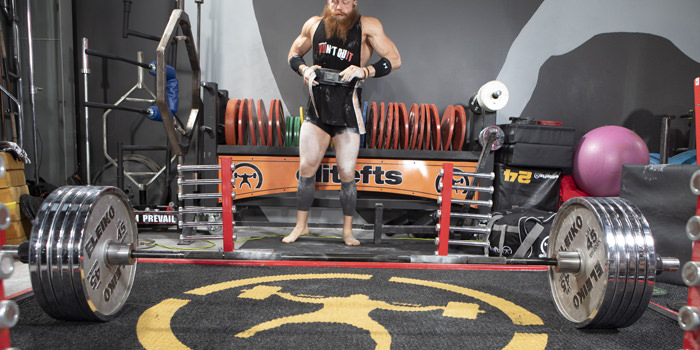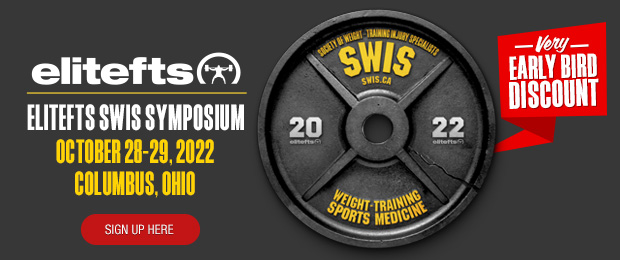
I am not a physique enhancement specialist. I am more interested in building size and strength without addressing the aesthetics. I want performance to be the end goal.
To this end, my philosophies are based on past strongmen and bodybuilders. To quote Reg Park or Bill Pearl (I can't remember who said this since both were from the golden era of the power bodybuilder), "If you can shoulder press 300 pounds for reps, you will never need to do a lateral raise in your life."
The program I outline below considers the methods to optimize hormonal manipulation using large compound movements for reps of six or less with longer rest periods (testosterone optimization) and compound movements using higher reps with shorter rest periods (growth hormone optimization).
I favour what I refer to as the Big Four since there are only push- and pull-related movements for both the upper and lower body segmentation. For this program, I will stick to these four movements.
I program a big and a small exercise for each of the movements. The first movement is for strength and size, and the secondary movement is for more size and strength. The primary movements will always be carried out as a straight set, but the secondary movements will be super-setted to optimize the training effect further.
It's simple and basic that follows a standard four-day-a-week training split of upper and lower body. Each session will be about 60–75 minutes maximum, comprising of four exercises. More is less in this program. So, if you feel like doing more, then I would say that you have not emptied the tank on the basic program. If you want a specific core movement, then this could be the fifth movement.
Consider the exercises in the gym you have access to that'll provide the best stimulus. Think heavy and basic. You will not go wrong. Here is a list of my personal favorites:
| Lower Body Push | Lower Body Pull | Upper Body Push | Upper Body Pull | Core |
| Squat variations | Deadlift variations | Bench Press | Pendlay Row | ½ Turkish Get Up |
| Sprinter’s Squat | Reverse Hyper® | Incline Press | Seated Row | Windmill |
| Lunge Option | Olympic Movement | Military Press | Yates Row | Suitcase Deadlift |
| Step-Ups Option | Good Morning | Landmine Press | Weighted Chins | Rollout |
| Prowler® Push | Hip Thrust | Javelin Press | Shrugs | Full Body Twist |
Now your list may be somewhat similar or quite different, but you must choose wisely as the ancient crusader knight advises Indiana Jones in the Holy Grail. Your success depends on the degree of muscle mass you can stimulate with each exercise to have a systemic anabolic effect.
Here's how I'd apply the methods to increase size and strength (the first two sessions for the week). Remember, one big and one smaller movement. I recommend selecting different exercises for the second two sessions of the week plan.
Monday – Lower Body Push & Pull
- Front Squat (Strength Wave)
- Trap Bar Deadlift (Maximal Strength 1)
- Reverse Lunge s/s Barbell Hip Thrust (RM Loading)
Tuesday – Upper Body Push & Pull
- Incline Bench Press (Strength Wave)
- Pendlay Row (Maximal Strength 1)
- Javelin Press s/s Weighted Chins (Size Wave)
Here are the details of the selected methods using a more strength-based protocol for the primary movements and a more size-based protocol for the secondary movements. The setup provides time efficiency and increased intensity.
| Method/ Weeks | 1 | 2 | 3 | 4 |
| Strength Wave | 2 x (6/5/4) @ (75%/80%/85%) | 2 x (5/4/3) @ (80%/85%/90%) | 2 x (4/3/2) @ (85%/90%/ 95%) | 3 x (3/2/1) @ 90%/95%/97.5%+) |
| Size Wave | 2 x (15/12/10) | 2 x (12/10/8) | 2 x (10/8/6) | 2 x (8/6/4) |
| RM loading | 50 reps @ 10RM | 30 reps @ 6RM | 60 reps @ 12RM | 40 reps @ 8RM |
| Maximal Strength (1) | 6 x 6 @ 75%% | 6 x 4 @ 85% | 5 x 5 @ 80% | 6 x 3 @ 90% |
There are many methods to consider to achieve the results you want. The sample above shows you how to organize your training plan to gain size and strength.
Remember to stimulate and not annihilate.
Ashley Jones has worked in three professional sports across 30 years and four continents. He was awarded the NSCA's Professional Coach of the Year in 2016. Ashley holds his CSCS (Certified Strength and Conditioning Specialist) since 1988 and is an honorary lecturer in the School of Therapeutic Sciences, University of Witwatersrand, Johannesburg, SA.











Strength 2x6/5/4 70%75%80%
Size 2x12/10/8
RM loading 30 reps @ 6RM
Maximal strength 6x4 85%
Day1 lower
back squat
Hip thrusts
Goblet squat
Leg extension
Day2 upper
Bench press
Barbell rows
Pull ups
DB pull overs
Day3 lower
Deadlift
Barbell reverse lunges
Pull throughs
Front squat
Day4 upper
Overhead press
Incline press
Weighted Chin-ups
Lat pull down
Day5 lower
Bulgarian split
Barbell rdl
Leg curls
Romanian deadlift
Day6 upper
Weighted dips
Cable row
Tricep push down
Face pull
Back Squat 4 sets
Hip Thrust 3 sets
Goblet Squat 2 sets
Leg Extension 1 set
Then each week I would re-order the same movements for a month so that each movement exposes you to a different set. number
Also on some of your days the movements are the same for example your day 5 where you have both a barbell ddl and a Romanian Deadlift in the one session.
I think this will improve your ability to recover from each workout and not exhaust you, hope that helps, Ashley
Dips 4 sets
Cable Row 3 sets
Tricep Push Down 2 sets
Face Pull 1 set
and over the course of a month expose each exercise to a different number of sets each week, I would also add more unilateral movements into each session, I hope that assists you, Ashley
Thks Mr jones for the article.
When you said "2 x (6/5/4) @ (75%/80%/85%)", you do 6set in total ?
Sorry for my english, im just french aaahaaa
Wave One: straight sets 8, 6, 4 @ 75%, 80%, 85%
Wave Two: Cluster sets 4+4, 3+3, 2+2 85%, 90%, 95%